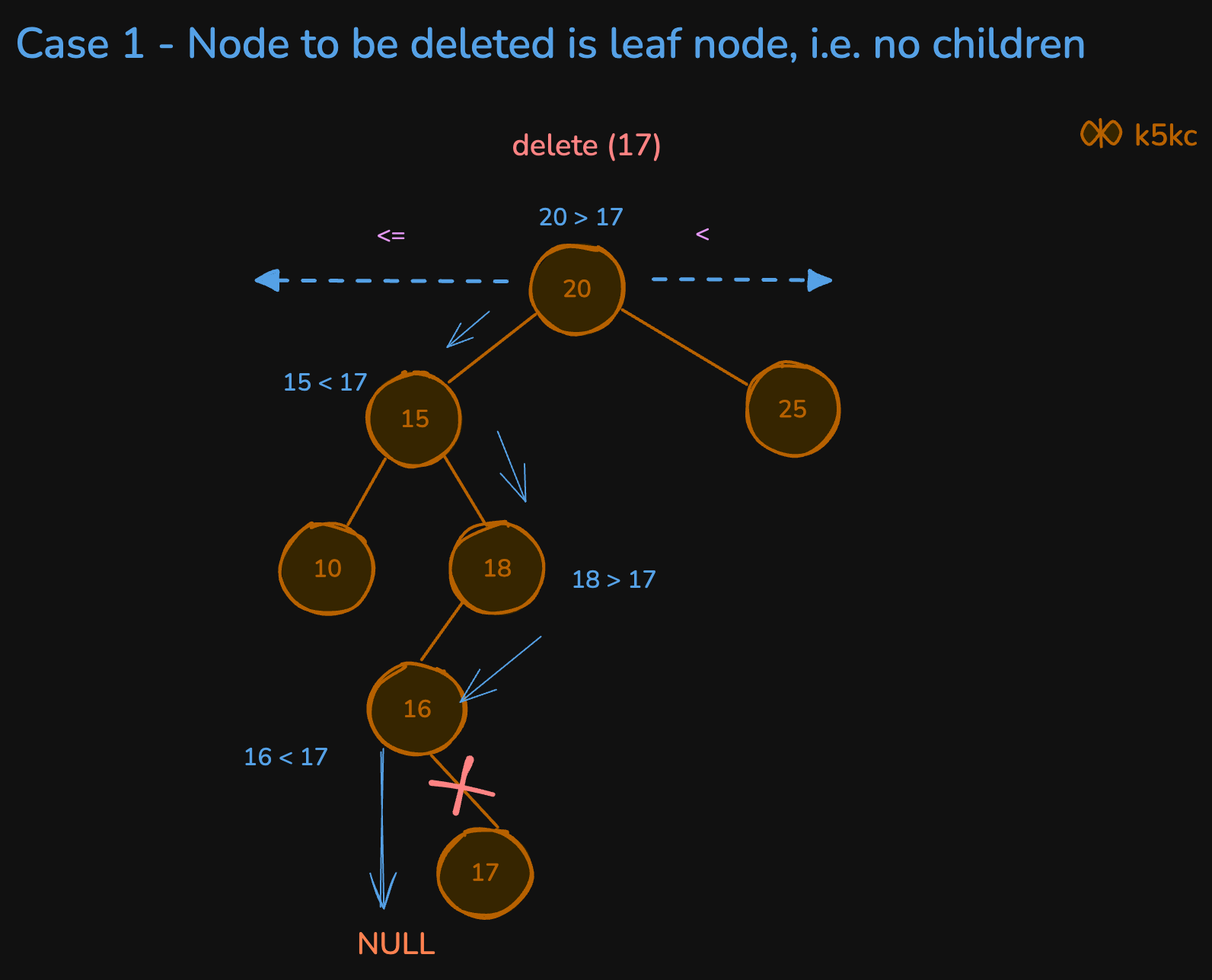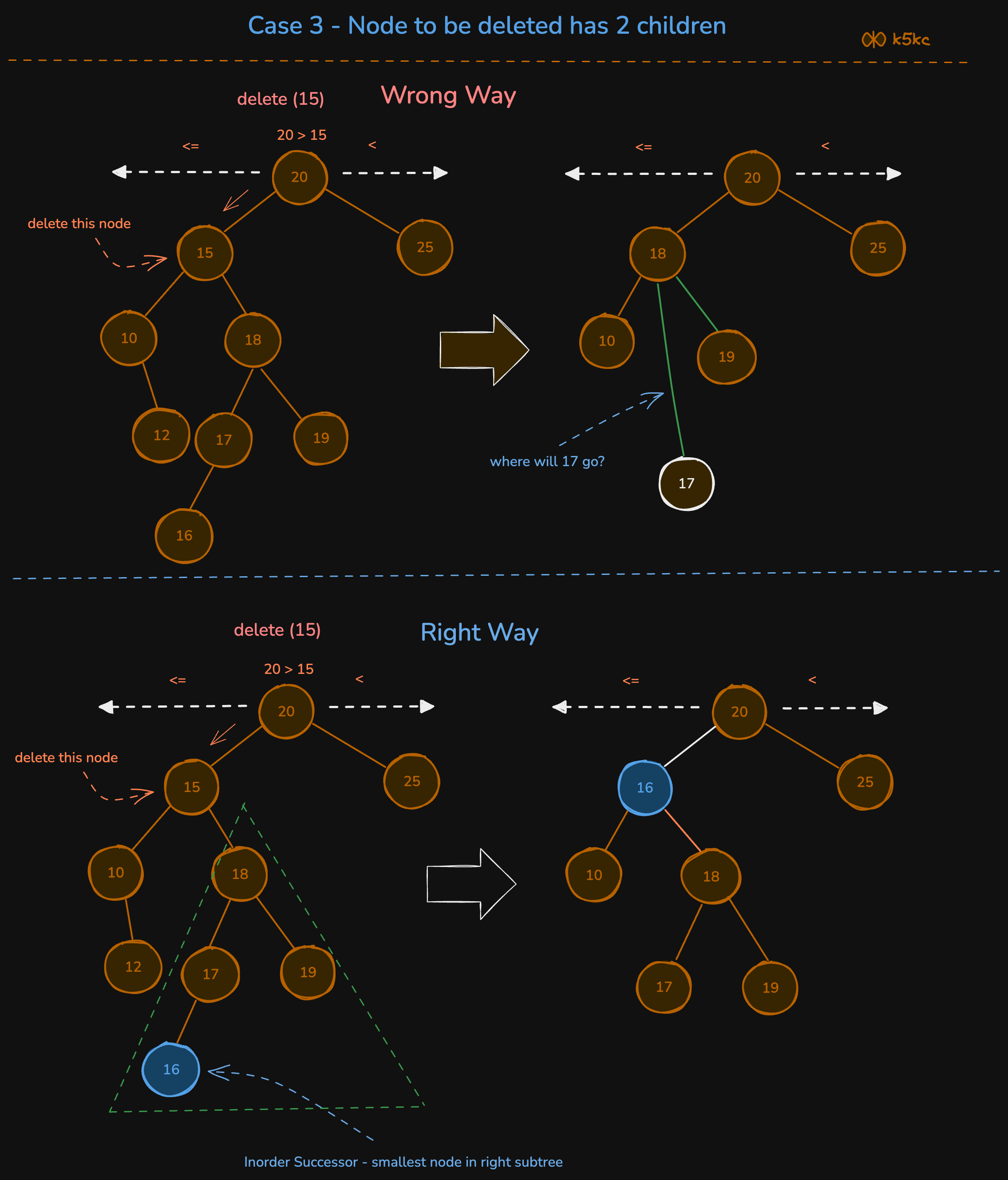Delete in a Binary Search Tree
Problem
Given a root node reference of a BST and a key, delete the node with the given key in the BST. Return the root node reference (possibly updated) of the BST.
Basically, the deletion can be divided into two stages:
- Search for a node to remove.
- If the node is found, delete the node.
Examples
Example 1:
Input: root = [5,3,6,2,4,null,7], key = 3
Output: [5,4,6,2,null,null,7]
Explanation: Given key to delete is 3. So we find the node with value 3 and delete it.
One valid answer is [5,4,6,2,null,null,7], shown in the above BST.
Please notice that another valid answer is [5,2,6,null,4,null,7] and it's also accepted.
Example 2:
Input: root = [5,3,6,2,4,null,7], key = 0
Output: [5,3,6,2,4,null,7]
Explanation: The tree does not contain a node with value = 0.
Example 3:
Input: root = [], key = 0
Output: []
Solution
Method 1 - Recursive + Finding inorder predecessor and successor
This operation is complicated than Find() and Insert() operations. Here we have to deal with 3 cases:
- Node to be deleted is a leaf node ( No Children).
- Node to be deleted has only one child.
- Node to be deleted has two childrens.
Node to Be Deleted is a Leaf Node (No Children)
its a very simple case, if a node to be deleted has no children then just traverse to that node, keep track of parent node and the side in which the node exist(left or right) and set parent.left = null or parent.right = null;
For eg. delete(root, 17)

Node to Be Deleted Has Only One Child
- Its a slightly complex case. if a node to be deleted(deleteNode) has only one child then just traverse to that node, keep track of parent node and the side in which the node exist(left or right).
- Check which side child is null (since it has only one child).
- Say node to be deleted has child on its left side . Then take the entire sub tree from the left side and add it to the parent and the side on which deleteNode exist, see step 1 and example.
 For eg. delete(root, 18)
For eg. delete(root, 18)
Node to Be Deleted Has Two Childrens
Now this is quite exciting. You just cannot replace the deleteNode with any of its child, Why? Lets try out a example.

Solution is to find the inorder successor.
- We need to find the [inorder successor](inorder-successor-in-binary-search-tree) of the node to be deleted. Inorder successor in BST is the minimum node just larger than the current node.
- The data of the inorder successor must be copied into the node to be deleted and a pointer should be setup to the inorder successor. This inorder successor would have one right child or zero children in case it is a leaf.
- This inorder node should be deleted using the same procedure as for deleting a one child or a zero child node.
Code
Java
class Solution {
public TreeNode deleteNode(TreeNode root, int key) {
if (root == null) {
return null; // Base case: Node not found
}
if (key < root.val) {
root.left = deleteNode(root.left, key); // Traverse left subtree
} else if (key > root.val) {
root.right = deleteNode(root.right, key); // Traverse right subtree
} else {
// Node found - proceed with deletion
if (root.left == null) {
return root.right; // Case: No left child
} else if (root.right == null) {
return root.left; // Case: No right child
} else {
// Case: Two children
TreeNode successor = findMin(root.right); // Find inorder successor
root.val = successor.val; // Replace with successor value
root.right = deleteNode(root.right, successor.val); // Delete successor
}
}
return root; // Return updated subtree
}
private TreeNode findMin(TreeNode node) {
while (node.left != null) {
node = node.left;
}
return node; // Smallest value in the subtree
}
}
Python
class Solution:
def deleteNode(self, root: Optional[TreeNode], key: int) -> Optional[TreeNode]:
if not root:
return None # Base Case: Node not found
if key < root.val:
root.left = self.deleteNode(root.left, key) # Traverse left subtree
elif key > root.val:
root.right = self.deleteNode(root.right, key) # Traverse right subtree
else:
# Node found - proceed with deletion
if not root.left:
return root.right # Case: No left child
elif not root.right:
return root.left # Case: No right child
else:
# Case: Two children
successor = self.findMin(root.right) # Find inorder successor
root.val = successor.val # Replace with successor value
root.right = self.deleteNode(root.right, successor.val) # Delete successor
return root # Return updated subtree
def findMin(self, node: TreeNode) -> TreeNode:
while node.left:
node = node.left
return node # Smallest value in the subtree
Complexity
- ⏰ Time complexity:
O(log n)for balanced BST;O(n)for skewed BST. - 🧺 Space complexity:
O(h)due to recursive calls.
Method 2 - Iterative
Code
Java
class Solution {
public TreeNode deleteNode(TreeNode root, int key) {
TreeNode parent = null, curr = root;
// Step 1: Search for the node to delete
while (curr != null && curr.val != key) {
parent = curr;
if (key < curr.val) {
curr = curr.left; // Traverse left subtree
} else {
curr = curr.right; // Traverse right subtree
}
}
// If the node is not found, return root
if (curr == null) {
return root;
}
// Step 2: Handle deletion cases
if (curr.left == null || curr.right == null) {
// Case: Node with one child or no children
TreeNode child = (curr.left != null) ? curr.left : curr.right;
// If the node to delete is the root, update root
if (parent == null) {
return child;
}
// Update parent's reference
if (parent.left == curr) {
parent.left = child;
} else {
parent.right = child;
}
} else {
// Case: Node with two children
// Find inorder successor
TreeNode successorParent = curr;
TreeNode successor = curr.right;
while (successor.left != null) {
successorParent = successor;
successor = successor.left; // Find the smallest node in the right subtree
}
curr.val = successor.val; // Replace node's value with successor's value
// Delete the successor
if (successorParent.left == successor) {
successorParent.left = successor.right;
} else {
successorParent.right = successor.right;
}
}
return root;
}
}
Python
class TreeNode:
def __init__(self, val: int = 0, left: Optional['TreeNode'] = None, right: Optional['TreeNode'] = None):
self.val = val
self.left = left
self.right = right
class Solution:
def deleteNode(self, root: Optional[TreeNode], key: int) -> Optional[TreeNode]:
parent, curr = None, root
# Step 1: Search for the node to delete
while curr and curr.val != key:
parent = curr
if key < curr.val:
curr = curr.left # Traverse left subtree
else:
curr = curr.right # Traverse right subtree
# If the node is not found, return root
if not curr:
return root
# Step 2: Handle deletion cases
if not curr.left or not curr.right:
# Case: Node with one child or no children
child = curr.left if curr.left else curr.right
# If the node to delete is the root, update root
if not parent:
return child
# Update parent's reference
if parent.left == curr:
parent.left = child
else:
parent.right = child
else:
# Case: Node with two children
# Find inorder successor
successor_parent = curr
successor = curr.right
while successor.left:
successor_parent = successor
successor = successor.left # Find the smallest node in the right subtree
curr.val = successor.val # Replace node's value with successor's value
# Delete the successor
if successor_parent.left == successor:
successor_parent.left = successor.right
else:
successor_parent.right = successor.right
return root
Complexity
- ⏰ Time complexity:
O(h) - 🧺 Space complexity:
O(1)